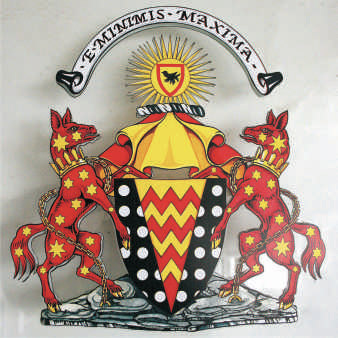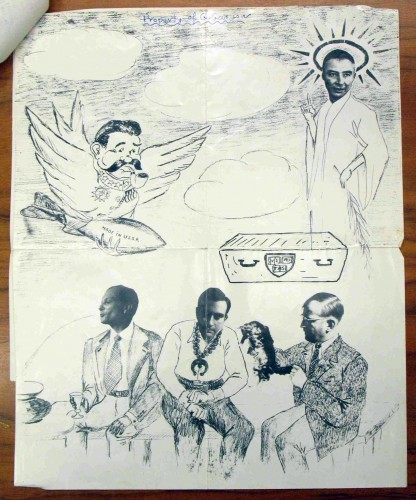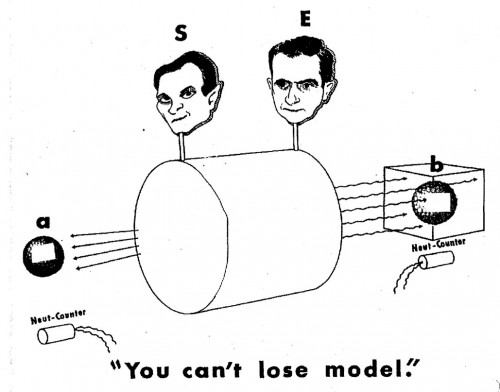Two small graphical things I wanted to share that came from feedback on a few recent posts.
The first is an explanation, of sorts, of the United Kingdom Atomic Energy Authority’s very unusual emblem:

I had ragged on the AEA’s design as being particularly stodgy, but I’ve been corrected. It’s just unduly weighed down by obscure symbolism, as a commentator pointed out. It was, apparently, designed by the Royal College of Arms with the following visual references:
- The central shield is black denoting the core of a graphite reactor, with inserted rods of silver uranium.
- The inverted triangle shows gold and scarlet bolts of heat and power.
- The energy released by splitting the atom is controlled by a pair of red pantheons, which are ferocious heraldic beasts. They are firmly held to the ground by thick golden chains to ensure the energy is firmly controlled.
- The pantheons have 13 six-pointed stars and two seven-pointed stars, totalling 92. These represent the 92 natural elements found in creation and also the atomic number of uranium.
- The five spikes on the collars signify the atomic number of boron, which was used to shutdown the early reactors.
- There are numerous representations of 8 for the atomic number of oxygen, 2 for helium and 1 for hydrogen – suggesting water. The whole gives insights into the four medieval elements of earth, air, fire and water.
- The sun represents the power of fusion, and the small shield with the black bird (a martlet) is the Coat of Arms of Lord Rutherford. He is recognised as the founder of nuclear physics.
- The steel helmet signifies the arms of a corporate body.
- The whole is placed on the earth on which flowers and plants are flourishing normally. [???]
- The motto “E minimis – maxima” means; ‘from the smallest, the greatest‘.
I thought that was interesting enough to share. Any resemblance between the “pantheons” and mutated horse-dogs is apparently entirely coincidental. And despite the barren, Moon-like appearance of the “earth,” it is apparently “flourishing normally.” Actually, the above image, painted on the doors of the Dounreay Prototype Fast Reactor, is slightly different than the other image of the emblem I had posted, which does have a more flourishing-looking ground cover, as well as a knight’s head.
All of this is a stark contrast from the US Atomic Energy Commission’s emblem, whose symbolism seems to have been, “it’s an atom, stupid.” I hereby promote the AEA’s emblem from “most boring” to “not as boring as I thought,” which leaves the current Department of Energy seal as the “most boring.”
Secondly, I have another cryptic drawing referencing the history of the hydrogen bomb, again by George Gamow. This one has been reproduced here and there, but a friend of mine came across an original version in the Gamow papers at the Library of Congress awhile back, and sent me his photographs of it and its captions. The drawing follows:
The attached caption (written, as always, in Gamow’s amusing handwriting and bad English) was as follows:
A drowing made by G. Gamow (with photographic inserts) which was handing [hanging?] in his office in the Los Alamos Scientific Laboratory during the dispute about the political necessity of developing an H-bomb and during the early stages of its developement after President Truman sayd: “Yes, go ahead.”
Top left is Comarade Stalin carrying the A-bomb made in the USSR.
Top right is Dr. Robert Oppenheimer who was objecting against H-bomb project on the basis that it is extremely difficult (actually it took less than two years) and will induce USSR to do the same (actually Russians worked on H-bomb when this discussion was taking place).
The coffin with the Harvard University coat of arms belong to
ProfessorDr. James B. Connant who said that: “H-bomb will be built only over his dead body.”On the bench below are Dr’s Stan Ulam, Edward Teller, and George Gamow, demonstrating their proposals for making H-bomb. The simbolism of these deviced cannot be explained because AEC classified them as “SECRET”.
The “simbolism” is fairly cryptic. The caption dates it around February 1950, so that might make it even harder to make sense of, as we’re talking about fairly early days when it comes to the final H-bomb design, but I’m not sure how reliable I find that dating. (The H-bomb debate was in late 1949-early 1950, though the caption was obviously written at a much later time.)
Looking for some insight into the technical discussions that were happening at this time, I took a gander at Anne Fitzpatrick’s quite detailed thesis on the early history of the H-bomb, “Igniting the Light Elements: The Los ALamos Thermonuclear Weapons Project, 1942-1952,” (Virginia Polytechnic Institute and State University, 1999), which was issued as LA-13577-T. Fitzpatrick’s work is notable as one of the few H-bomb histories that have been written by a non-participant but also with access to classified information. (The whole thing was, of course, screened for security, and she notes in a few places where she was asked to label things merely as “special” to make them more vague.)
Fitzpatrick notes that Gamow spent a sabbatical year at Los Alamos in 1949-1950, to help with work on the H-bomb, which matches up with his caption above. While there, he seems to have produced a bevy of H-bomb-themed drawings, of which she reproduces three. One shows the complexity of the energy flow problem in a Super, another portrays the hydride bomb (“Elmer”) as “unattractive and clumsy” in comparison with a lower-yield water penetrating fission bomb (“Elsie”/”L.C.”), and the another portrayed Ulam and Teller themselves as the ultimate Super design:
But back to the original, “simbolic” Gamow image. Ulam’s spittoon almost surely references the fact that you’re using forces at a (relative) distance to compress the secondary, right? Whether one does that by hydrodynamic lensing (Ulam’s original proposal) or radiation implosion (the later Teller-Ulam design) doesn’t seem to be distinguishable. On the other hand, Ulam didn’t propose that until 1951, so this might be something else entirely. Fitzpatrick’s thesis doesn’t spell out any additional Ulam proposals that I saw.
Teller’s is much more cryptic. Looking at Fitzpatrick’s thesis, she says that at this time, Teller was championing a device dubbed “Little Edward.” (Oh myyyy.) This was, she says, “a giant, high-yield multi-crit gun device proposed by Teller that was supposed to produce x-radiation to ignite the D-T mixture in the Super.” Could that be the string of beads with the giant Omega in the middle of it? It sounds like an ungainly device, and indeed, it was eventually dropped as being very wasteful and without much guarantee that it would do anything better than other designs on the table.
And lastly, there’s Gamow’s. According to Fitzpatrick, Gamow’s design was known as the “Cat’s Tail.” She says that it was “a variation on the large fission detonator purported to ignite the Super… Gamow theorized that the Cat’s Tail needed less T[ritium] than had been assumed in the ENIAC Super problems, but could not guarantee this.” Since, as far as I know, Gamow’s designs have never been discussed openly (and were not successful), it’s pretty difficult to try and correlate such an image to an actual bomb design.
Presumably there were no cat-driven hydrogen bombs, though having owned a cat, I can see that one might be seriously tempted to exploit some of their malicious energy in this way. I welcome any and all additional interpretations.




What about the squash-blossom necklace that Teller is wearing? It’s certainly a reference to New Mexico and Los Alamos, but what does it mean? It’s Native American, appropriated by Anglos for decoration. Anglo men (that would include Teller) don’t wear them.
So Gamow must have intended something by it. Could be that Teller was back at Los Alamos, or wanted to be. I can’t keep track of all those comings and goings, but I suspect you have the dates, Alex!
I’ve never seen one of those before, Cheryl, but there’s quite a striking resemblance. As for the dates, Teller “resigned” from Los Alamos in September 1951, after Marshall Holloway was announced to lead the new thermonuclear design and development program, a job Teller coveted. This was his period of pushing hard for Livermore.
That thing around Edward’s neck is a Navajo squash blossom necklace (he liked Indian art). What you call an omega is really a symbolic vagina in the Navajo art world. Go figure what _that_ means in context!
This brings to mind Hans Bethe’s famous comment about the development of the H-bomb: “After the H-bomb was made, reporters started to call Teller the father of the H-bomb. For the sake of history, I think it is more precise to say that Ulam is the father, because he provided the seed, and Teller is the mother, because he remained with the child. As for me, I guess I am the midwife.” A little awkward…